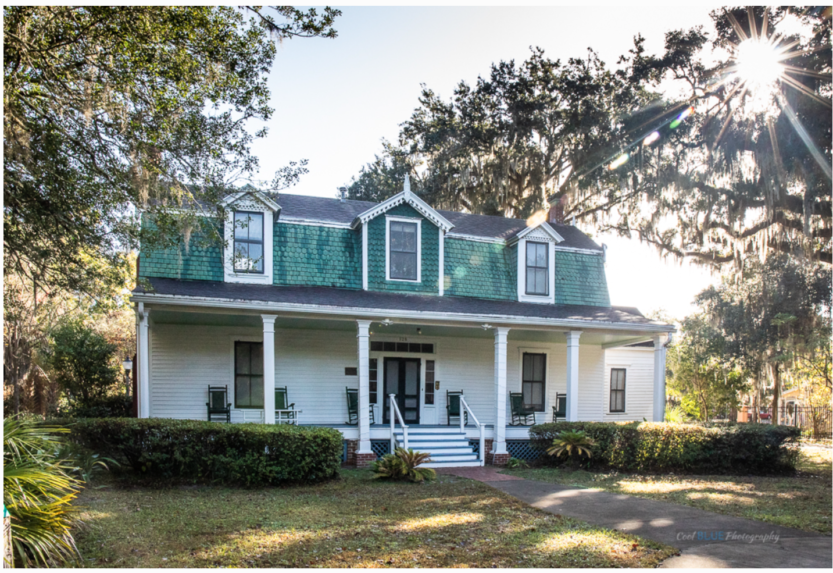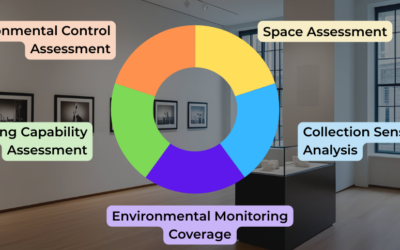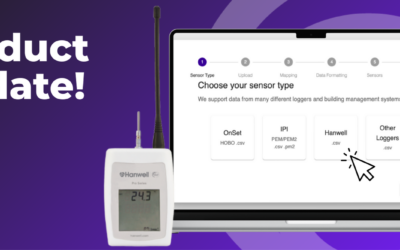At CONSERV we care about collections AND the people who care for collections. We recently sat down with Chloe Richardson, the Collections Coordinator at the Matheson History Museum in Gainesville, Florida to talk about how she uses Conserv for monitoring temperature and humidity in historic buildings located in Florida’s most humid city.
As a Gainesville native and art history major, the collection at the Matheson has always been of “personal interest” to Chloe, particularly the 19th century photography. She first started working there as a registrar while pursuing her Master of Museum Studies degree at the University of Florida. After moving to North Carolina for a time and working at other museums set in historic homes, Reynolda and Old Salem, she eventually returned to Gainesville and the Matheson History Museum.

- Chloe Richardson, Collections Coordinator at the Matheson History Museum.
Now serving as the Collections Coordinator, Chloe is in charge of committee meetings, visitor services, processing donations, and interfacing with people who have questions about the collection. When she is not cataloging a backlog of artifacts, she also cares for the historic spaces. The main part of the museum is in an old American Legion hall built in the 1930’s with a basement used for collection storage.
The library and archives are housed in a gospel tabernacle built around the same time, and the historic Matheson house was built in 1867.
Small staff + historic buildings + high humidity
With a goal to preserve and interpret the local history of Gainesville and Alachua County, the Matheson History Museum is important to the surrounding community. But looking after a collection housed in historic buildings with original windows in inland Florida brings challenges. The Matheson staff have to monitor things like intense relative humidity, high temperatures, termites, and water leaks.
“We recently got named the most humid city in Florida,” Chloe told us, “So we have very particular issues here.”
The Matheson has a small staff– there are only two local employees and they rely heavily on volunteers– so it is impossible to physically monitor all the buildings themselves.
Monitoring temperature and humidity in a historic house
Thanks to unplanned additions in the late 19th century, the relative humidity in the historic house was a problem that needed to be addressed. It felt even more humid inside than it was outside! The house also had electrical problems, so the HVAC would go out sometimes. Chloe realized she had to monitor the historic house somehow to protect the collection. “I actually just bought one of those little $10 monitors you stick on your fridge, and it tells you the temperature and humidity,” Chloe said. She would take time out of her busy day and limited hours to log the data from the D.I.Y. temperature and humidity monitor on a spreadsheet.
The museum did have some existing monitoring systems, but they were antiquated.
The hygrothermograph in the basement of the main building had long run out of paper. “It’s an artifact itself at this point,” said Chloe.
The same went for other defunct sensors at the museum. Chloe told us, “I’ve actually found other humidity monitoring systems around the museum that I think are from the nineties…You try to look through the old files and you have no idea what this thing is or how long it’s been since it functioned.”
A better solution for a busy collections coordinator
Chloe needed a real-time remote monitoring solution to understand what was happening in the historic house as well as to make sure their basement was viable for collection storage. “There’s really no other option because we’re part-time. It’s often that we’re too busy to be over there,” Chloe explained. Her director happened to learn about Conserv at the Southeastern Museums Conference (SEMC) annual meeting. When Chloe looked into our environmental monitoring subscription and realized the cost fit their limited funding, she ordered a small number of Conserv data loggers to try out the platform.
Chloe found the Conserv sensors easy to install. “It was very easy. Like it was almost too easy. You’re like, ‘there must be more to it,’” Chloe told us.
Conserv’s LoRaWAN connectivity allows for real-time monitoring in the historic house despite the lack of WiFi in the building.
Even though the house is 300 feet away through a park, both sensors communicate easily with the gateway in the main museum.
Conserv sensors now let her know the current temperature and humidity without having to physically visit. “We can have monitors over there, check on the internet, and they can tell us the HVAC is working,” she said.
Our remote monitors paid dividends almost immediately.
“Conserv right away showed us that something was wrong with the attic, and we were able to say that we need to invest to get the attic vented,”
Chloe explained, “it definitely made a difference. It’s made our power bills go down a little bit.” In the same vein, she was surprised to learn that her concerns about the humidity in the basement of the main museum building were unfounded. The Conserv sensor that replaced the hygrothermograph revealed that the conditions were actually pretty good, so they could use resources elsewhere and feel confident about storing material in the space.
The benefits of a state-of-the-art environmental monitoring system
Chloe employs the “easy-to-read” charts created by Conserv’s software to communicate more effectively with her boss, the board of the museum, and donors to help justify funding for needed updates. The inclusion of the local weather report lets her know how conditions outside the building compare to the interior.
“Now, if we apply for a grant, we can clearly say that the humidity in the house is over the outdoor humidity,”
she told us, “now that we have the data, we can say that we do need to really try and address this. We can get funding, we can get support from our community for it.” The data shows that venting the attic wasn’t a total fix, so next they are looking to add a subfloor to help with the humidity and prevent pests.
Alerts for peace of mind
Chloe appreciates the email alerts, so she can act if the temperature or humidity spikes.
“I have a humidity alert set up on the house, and I get it like every week. I get an email saying ‘you’re in the mold zone.’…if it ever went off in the main building, we would know something was wrong with our HVAC,”
she explained. She is also considering obtaining a Conserv water leak detection sensor for the basement in the main building where they once had flooding during large storms. Until then, Chloe uses the standard Conserv sensor to deliver some peace of mind. Chloe told us that during Hurricane Ian, “my boss was very nervous about water, and I was able to check remotely and see that the humidity in the basement was still normal.”
Beyond monitoring temperature and humidity
Though Chloe uses our sensors mostly for monitoring temperature and humidity, she wants to check out the built-in light monitoring capability, and utilize the IPM features of the software going forward. “I feel like there is so much it can do already that we’re not even implementing yet,” she told us, “it’s already helped us so much, and I feel like it’s definitely going to help us in the future, too.” Conserv deals with replacing batteries as well as updating and calibrating sensors so Chloe doesn’t have to.
“You take care of the technology part of it so we don’t have to keep up with it,” she said.
As a partner in conservation, we are there when she needs us, “you all were so helpful. Any question I had, you answered,” she raved. We love that we can help Chloe preserve local history in the historic buildings at the Matheson.
If you have any questions about environmental monitoring, integrated pest management, or just want to talk about preventative conservation, please reach out to us! Don’t forget to check out our blog or join our community of collections care professionals where you can discuss hot topics, connect with other conservators or even take a course to get familiar with the Conserv platform.




